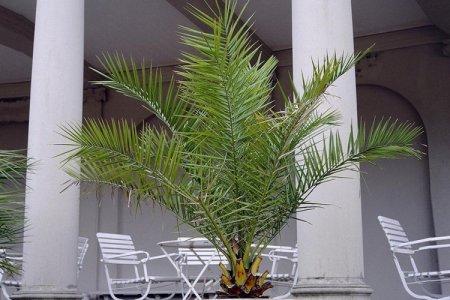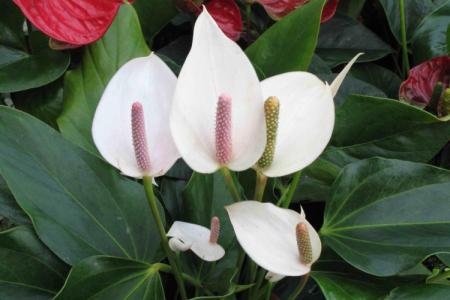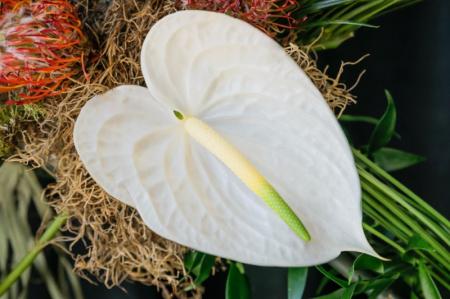
Decorative variegated pedilanthus has deservedly become a favorite of flower growers throughout Russia. It is traditionally grown as a houseplant, although it does well outside in summer. We tell you about the variety of types and the intricacies of care!
general information
Pedilanthus is another species of milkweed that thrives in our latitudes. Outwardly, it is a small bush or tree with decorative leaves and the ability to bloom. Together with his fellows, the pedilanthus came to us from different parts of America.
Pedilanthus attracts attention with a bizarre broken shape of the stems. In some countries, it was even called "the devil's backbone" for its specific appearance. The buds of the plant are also very unusual - in the form of a shoe.
Medium-sized pedilanthus fox - up to 10 cm, depending on the size of the plant itself. They have a sharp edge, an elongated shape and, as it were, waxed on top. Apical umbrella inflorescences are collected from small red or pink flowers.
In everyday life, the pedilanthus is surrounded by a number of funny signs and superstitions. For example, it is believed that such a flowerpot as a gift will certainly entail radical changes in life. Or that for well-being on the personal front, you can't keep variegated varieties at home.

Types of pedilanthus
Despite all the variety of pedilanthus species in nature, only a few have taken root at home. We will dwell on them in more detail!
Titimaloid pedilanthus
The most popular type with shoots bizarrely curved in different directions. The leafy stems resemble a staircase that stretches upward. Such a pedilanthus is very sensitive to external conditions, which instantly affect the color of the foliage.

Spur pedilanthus
A tall species in nature easily stretches up to 3 m, although it is almost impossible to get such a result at home. This pedilanthus has beautiful and large oval leaves with a neat wavy edge.

Pedilanthus Finca
It is a very moisture-loving variety with beautiful and juicy bright green leaves. With age, the plates brighten and become variegated, and the edge acquires a pinkish tint.

Koalkomanen pedilanthus
It is rightfully considered one of the most beautiful and original in its family. In addition, it is also unpretentious, although it can shed its leaves in response to sudden temperature fluctuations.

Large-fruited pedilanthus
Not the most decorative, but very original look with bare elongated stems that store water supplies. Small leaves look like scales, but the flowers are very pretty.

Pedilanthus care
Domestic pedilanthuses are much smaller than their wild relatives. But even so, if you wish, you can grow a tree up to 2 m high.The diameter of the shoots does not exceed 2 cm on average.
Temperature
The ideal summer temperature for pedilanthus is from +20 degrees, so from the end of spring it can be taken out to the balcony or outside. So that during the winter the plant gains strength for flowering and does not lose its decorative effect, we advise you to maintain the temperature up to +15 degrees.

Lighting
Due to the specifics of its origin, pedilanthus needs bright lighting. But it does not tolerate aggressive direct rays too well, so in the midst of a sultry day, we advise you to shade it a little with tulle.

Watering
Pedilanthus needs frequent, but not overly intense watering. It is better to water it every other day, but little by little, than to water the roots once a week. In winter, this frequency is significantly reduced. The plant is very sensitive to dryness, so that its leaves wither and fly around very quickly.

The soil
Any soil is suitable for growing pedilanthus, as long as it is loose enough and with good drainage.Use expanded clay, polystyrene, vermiculite and other auxiliary materials. Remember that the roots of the plant are difficult to tolerate stagnant moisture.

Fertilizers and feeding
From spring to autumn, we recommend feeding the pedilanthus with universal fertilizers every 4 weeks. But choose a mixture with a low nitrogen content, otherwise variegated varieties will become simply monochromatic. As with other milkweed, cactus or succulent plant food is suitable.

Pruning
Pedilanthus can be shaped, restrained and decorative. The best time for pruning is early spring, before the main processes have started. Pruning long shoots by a third stimulates branching.

Transfer
Pedilanthus cannot be transplanted without urgent need, because it does not tolerate such an intervention very well. Only if the pot has become hopelessly small, take a new one a few centimeters larger. In other cases, it is enough to change the top layer of the substrate once every couple of years.

Reproduction and planting of pedilanthus
Pedilanthus seeds are hardly propagated by seeds, because at home they rarely set and do not germinate well. It is much easier and faster to root cuttings. Cut off several shoots up to 10 cm long from an adult and healthy bush, and then cut off the leaves and let them dry for days.
Plant the cuttings in wet sand at an angle and cover them with plastic wrap or a bottle for quick rooting. Young plants need warmth, high humidity and regular ventilation. Use gloves when working, because milkweed juice is toxic.

Pest and disease control
Most often, indoor pedilanthus is sick due to improper care, and these are usually fungal diseases. If the leaves become covered with brown spots, the shoots turn black, and the old stems become softer - an urgent need to get rid of all affected areas.
We recommend replanting the plant, carefully examining its root, treating everything with fungicides and adjusting the watering regime. If it is too late to save the bush due to damage to the stem or roots, you can have time to root healthy cuttings.
Of the pests, spider mites, mealybugs, aphids and whiteflies are occasionally found. There is enough treatment with special insecticides for indoor plants.

Pedilanthus - photo
Like all variegated, each pedilanthus is special and unique. It will wonderfully decorate a window sill, curbstone or rack.


























